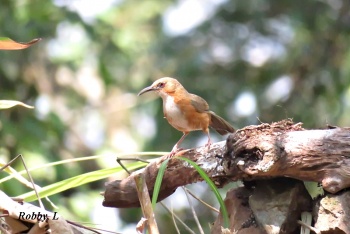Alternative name: Salvadori's Scimitar-Babbler
Includes: Red-eyed Scimitar Babbler

Photo © by Alok Tewari
Forest-edge, Sattal, Dist. Nainital, Uttarakhand Himalayas, Alt. 5500 ft., India, 14 November 2018
- Erythrogenys erythrogenys
Pomatorhinus erythrogenys
Megapomatorhinus erythrogenys
Identification

Photo © by robby thai
Doi Phu Hom Pok National Park, Thailand, 5 March 2017
22 - 26cm (¾-10¼ in). A rather large Scimitar-Babbler:
- Broadly orange-rufous from forehead and face to flanks and vent
- Whitish throat and belly
- Indistinct broad greyish-white streaks from chin to breast
- Small black malar
- Long whitish-horn bill
- Eye pale or red (subspecies dependent) surrounded by dark blue bare skin and white spots
Sexes similar, juveniles paler above with duller rufous parts.
Similar species
Large Scimitar-Babbler has dark eye and grey flanks. Spot-breasted Scimitar-Babbler has blackish spots on breast.
Distribution
Found from northeast Pakistan over the Himalayas to Bhutan and in eastern Burma and northwest Thailand.
Common in parts of its range.
Taxonomy
This is a polytypic species[1] consisting of 5 subspecies.
Both species, Rusty-cheeked and Spot-breasted Scimitar-Babbler are also sometimes regarded conspecific. Further study is required to solve the taxonomy of this complex.
Berryman et al [5] propose this taxon be split into two given many plumage and vocal differences between subspecies groups (the most obvious of which are different eye colours:---red and white respectively). They elevate subspecies celatua and imberbis as "Red-eyed Scimitar Babbler", E. imberbis, leaving subspecies erythrogenys, ferrugilatus and haringtoni as "Rusty-cheeked Scimitar Babbler" (strict sense).
Subspecies
- E. e. erythrogenys: Himalayas of northeast Pakistan and northern India
- E. e. ferrugilatus: Montane forests of Kashmir to central Nepal
- E. e. haringtoni: Himalayas from Sikkim to Bhutan
- E. e. imberbis: "Red-eyed Scimitar Babbler". Karenni, eastern Myanmar
- E. e. celatua: "Red-eyed Scimitar Babbler". Shan States, eastern Myanmar, and northwestern Thailand
Other sources [1] include haringtoni in ferrugilatus.
Habitat
Thick scrub and dense undergrowth at forest edge, scrub in open pine forest, secondary growths, thickets and bush-covered hillsides. Found at 300m up to 2400m, sometimes up to 3000m.
Behaviour
Diet
Feeds on insects, larvae, seeds and berries.
Usually seen in pairs in summer and in small groups of up to 12 birds in the rest of the year. Seldom in bird-waves. Mostly seen on the ground.
Breeding
Breeding season February to Jul. The nest is a loose dome with a broad entrance. It's made of coarse grasses, dry fern, bamboo and other leaves and placed on the ground, sheltered by vegetation or rocks or in a thick bush up to 1.2m above the ground. Lays 2 - 4 eggs.
Movements
Resident species.
Vocalisation
Recording by Alok Tewari
Repeated calls given by one bird, morning time, as it moved through a large cactus plant. Background chirping by a group of Oriental White-eyes and group of White-throated Laughingthrushes are heard. One call by Himalayan Bulbul heard in the middle part of the recording.
References
- Del Hoyo, J, A Elliott, and D Christie, eds. 2007. Handbook of the Birds of the World. Volume 12: Picathartes to Tits and Chickadees. Barcelona: Lynx Edicions. ISBN 978-8496553422
- Rasmussen, PC and JC Anderton. 2005. Birds of South Asia: The Ripley Guide. Barcelona: Lynx Edicions. ISBN 978-8487334672
- Clements, J. F., T. S. Schulenberg, M. J. Iliff, S. M. Billerman, T. A. Fredericks, J. A. Gerbracht, D. Lepage, B. L. Sullivan, and C. L. Wood. 2021. The eBird/Clements checklist of Birds of the World: v2021. Downloaded from https://www.birds.cornell.edu/clementschecklist/download/
- Birds of Indian Subcontinent : Richard Grimmett et al, 2011, OUP
- Berryman, A.J., P. Boesman, and N.J. Collar (2023) Evidence from citizen science and museum specimens suggests species rank for Erythrogenys [erythrogenys] imberbis (Salvadori, 1889), ‘Red-eyed Scimitar Babbler’. Bulletin of the British Ornithologists’ Club 143: 375–384
doi: 10.25226/bboc.v143i3.2023.a14
Recommended Citation
- BirdForum Opus contributors. (2025) Rusty-cheeked Scimitar Babbler. In: BirdForum, the forum for wild birds and birding. Retrieved 2 May 2025 from https://www.birdforum.net/opus/Rusty-cheeked_Scimitar_Babbler
External Links
GSearch checked for 2020 platform.1



